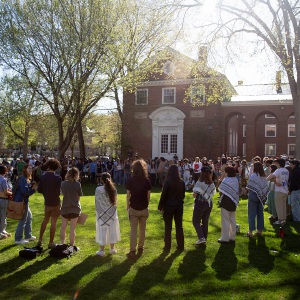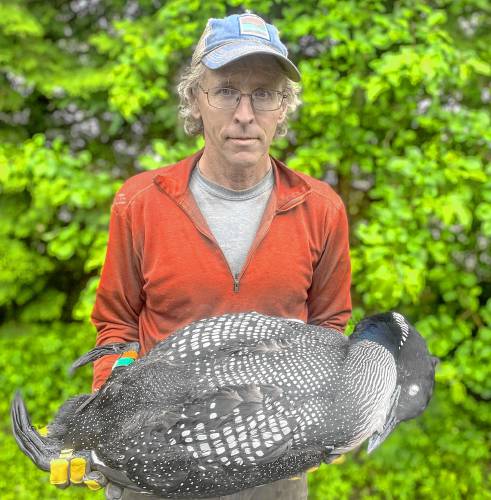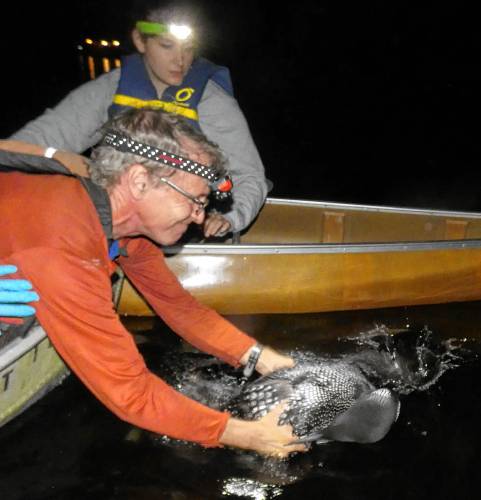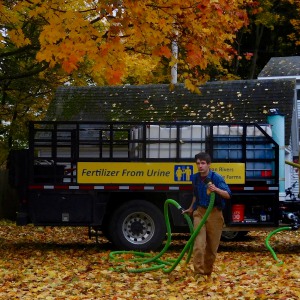Vermont’s oldest loon dies at the estimated age of 31
| Published: 06-24-2023 10:13 PM |
Just after dusk, as the dark began to settle on Newark Pond, a spotlight on a boat shone onto the water as it floated toward a breeding pair of loons.
It was Aug. 2, 1998. Eric Hanson, then a 32-year-old visiting biologist at the Vermont Institute of Natural Science, pulled out a cassette player and began to play loon calls. Wails, hoots and tremolos reverberated over the lake, convincing the pair that there was a third loon in their territory.
As the loons grew distracted by the calls and mesmerized by the light, the crew on board shot a large salmon dip net in front of them. At the splash, the male loon dove instinctively — swimming directly into the net. Lifting the loon out of the water, Hanson quickly placed a towel over his head to calm him, then headed back to shore.
Over the next 20 minutes, an elaborate dance took place on the grassy bank. Two people held the bird in place, while a third person took blood and feather samples to test for mercury as part of a regionwide study.
Before releasing the loon back into the pond, Hanson placed two bands on each of his legs, green over orange on the left and yellow over a silver U.S. Fish and Wildlife band on the right — unique combinations with an identification number of 898-09100.
Those bands have allowed Vermont biologists to monitor this loon for the past 25 years. “That bird could show up in Long Island or Massachusetts, and you could report that to the U.S. Fish and Wildlife Service lab,” Hanson said. “They would be able to look that band combo up and tell exactly where that bird was banded.”
Newark Pond Male, as Hanson refers to the loon, was found to have died recently at an estimated age of 31. He was the oldest documented loon in Vermont. It’s possible he could be even older, as that age is based on the assumption that the loon was 6 years old and in his first year of nesting during that first encounter, Hanson said.
Over the past 45 years, the Loon Conservation Project, started by the Vermont Institute of Natural Science, spearheaded by the Vermont Center for Ecostudies and supported by the Vermont Fish and Wildlife Department, has helped bring the common loon back to lakes across the state and made huge strides in research, education and advocacy.
Article continues after...
Yesterday's Most Read Articles
 Dartmouth administration faces fierce criticism over protest arrests
Dartmouth administration faces fierce criticism over protest arrests
 Three vie for two Hanover Selectboard seats
Three vie for two Hanover Selectboard seats
 A Look Back: Upper Valley dining scene changes with the times
A Look Back: Upper Valley dining scene changes with the times
 Norwich author and educator sees schools as a reflection of communities
Norwich author and educator sees schools as a reflection of communities
When Newark Pond Male was banded, the loon was still on Vermont’s endangered species list (it wouldn’t come off until 2005), but the population had already begun to rise. That year, researchers counted 40 territorial pairs, of which 30 pairs nested. In 2022, the total number of territorial pairs had bloomed to 139 with 106 nesting pairs.
As for Hanson, his four-month stint banding loons and collecting samples for mercury testing turned into a decades-long career as the lead biologist of the Loon Conservation Project. Today, he manages a team of biologists, as well as 400 local volunteers, and still uses a cassette player to blast loon calls across a lake, though he says he’s been meaning to upgrade.
The Vermont team is just one of many that band loons for study. “We’re a small player in all of this,” Hanson said.
The 32 loons the team banded between 1998 and 2003 have added to research that has provided key insights about the species. Banding has provided a way of tracking loons as they compete for territory and migrate in the winter months.
“There was a period there for about 10 years that we didn’t see (Newark Pond Male),” Hanson said. “So we think he may have gotten kicked out of the territory for a few years and then won his way back into the territory.”
The team has noted that the loons “migrate to the ocean in winter and disperse to their breeding grounds,” Hanson wrote in the Loon Conservation Project newsletter last year. “Our Newark Pond male flies directly to Cape Cod and has traveled an astounding 15,000 miles in his lifetime.”
Researchers have also learned through banding that loons don’t mate for life.
Newark Pond Male’s mate disappeared sometime in the early 2000s. It’s possible she died or was challenged by another female and lost her place in the lake, Hanson said. Loons are “site-specific, rather than mate-specific,” he said.
“To me, it’s so cool that these birds are kind of vying for territory,” he said. “They’re always checking each other out. The non-breeders are checking each other out. They’ll have a dispute. They might hold it, they might lose it, and if they lose it, then there’s a change in the mates.”
Soon, Newark Pond Male will be sent to Tufts University School of Veterinary Medicine, where Dr. Mark Pokras and a few of his students will conduct a necropsy to determine the cause of death. Hanson expects to receive the results by mid-July.
“Fingers crossed, I’m hoping it’s something more related to old age and competition with another loon,” Hanson said. “I’m always worried if it’s another lead sinker bird. (Pokras) just did one that I collected last fall from Lake Champlain, and sure enough. This could be the 11th lead bird that we’ve had in five years.”
The necropsies, which the project began in partnership with Dr. Pokras in 2020, have confirmed that ingestion of lead is the leading cause for death in loons. Recently, the team has also found a slew of deaths related to fungal disease.
In response to the uptick in lead mortalities, the team is launching a new initiative next month: installing containers around lakes, where lead tackle and fishing line can be safely discarded. The goal, Hanson said, is “to try to just get more lead out of people’s tackle boxes.”
He also urges anglers to reel in when loons are passing by so they won’t get caught up in a fishing line or go after a fish that’s attracted to the bait. Loons can end up getting a hook caught in their gizzard. “They can actually live through that because it’s an incredible organ for dissolving metals and things,” he said.
“But if there’s a lead piece on it, it’s a dead loon.”
Newark Pond Male is far from the first loon Hanson has lost. “I’m worried about my volunteers on that pond because they get so attached,” he said. “I joke that I put on my psychotherapy hat to do grief counseling a lot every year.”
Restoring the loon’s natural life-death cycle to a rate that sustains a robust population is the ultimate goal of conservation efforts. Over the past decade, chick survival rates have declined by around 10%, mainly due to competition from other chicks as well as predatory bald eagles.
But Hanson is not worried. “I’m actually kind of hoping the competition kind of slows the growth rate a little bit,” he said. “Not a bad thing at all.”
Newark Pond Male’s death comes as loon chicks are beginning to hatch all across the shorelines of Vermont’s wild lakes. Other breeding pairs are just beginning to nest, starting a month-long incubation period when loons are most vulnerable, said Hanson.
“One of the drivers, probably, of why they declined so much 50, 60, 70 years ago was (that loons were) just not making it through the nesting cycle,” Hanson said.
As summer sets in and people begin taking their kayaks, canoes and motorboats onto lakes, Hanson is urging the public to keep their distance from loon nests, which are usually found on small islands or on the banks of lakes. Many, but not all, of the nests are now equipped with nest warning signs that caution boaters, kayakers and anglers to keep a distance of 50 to 100 feet.
Those signs are already paying off.
Volunteers on Lake Memphremagog have reported the lake’s first breeding pair in over a decade, and Lake Rescue, which stretches from Plymouth to Ludlow, has seen its first chick hatch.
“They nested last year and failed. This year, they nested again. We got signs out to help give them a little space. And they just hatched two or three days ago,” Hanson said.
He added, “It’s the first time we’ve ever had a chick on that lake in 45 years of this project.”
With care, they too may live for more than 30 years.



 The future of fertilizer? Pee, says this Brattleboro institute
The future of fertilizer? Pee, says this Brattleboro institute From dirt patch to a gateway garden, a Randolph volunteer cultivates community
From dirt patch to a gateway garden, a Randolph volunteer cultivates community 
